Summer soap making requires temperature control to prevent saponification issues. You'll need to pre-cool lye solutions in the refrigerator, keep oils in ice baths, and work during cooler morning or evening hours. Consider using fans, slow cookers with adjustable settings, and insulated containers to maintain ideal temperatures between 120-130°F. Increasing water content and reducing fragrance loads will help manage heat acceleration. These adjustments guarantee your summer soaping projects succeed without frustrating volcanoes or false trace.
Understanding Heat Challenges in Summer Soap Making
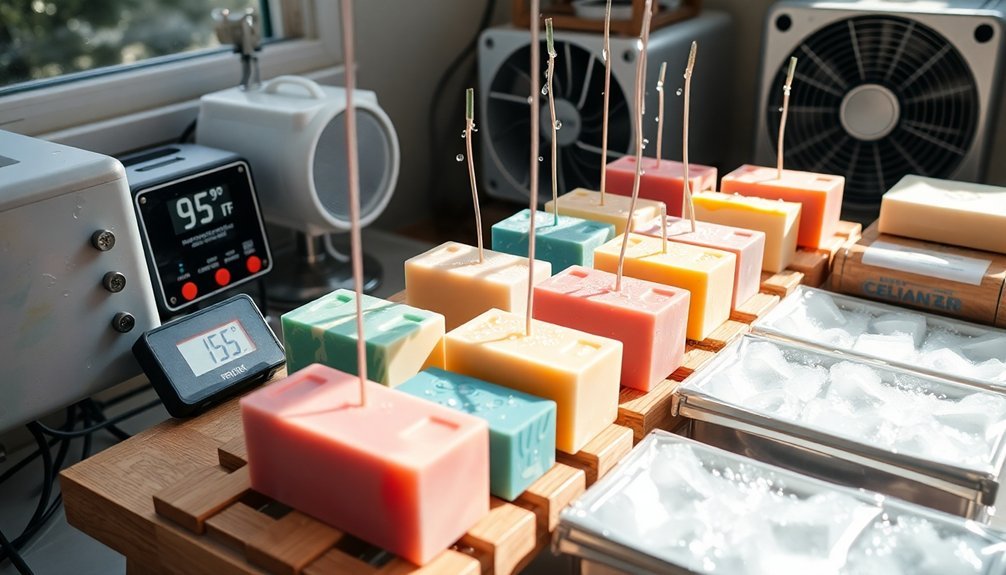
When summer temperatures soar, your soap making process faces unique challenges that can greatly impact the quality of your final product. High ambient temperatures can disrupt the delicate balance needed for proper saponification. As temperatures exceed 130°F, you'll risk soap volcanoes and glycerin rivers during gel phase.
Summer heat keeps oils in a more liquid state, often causing rapid trace that's difficult to control, especially in recipes with solid fats. Your lye solution and oils should ideally remain between 120-130°F to guarantee successful saponification without false trace complications.
To maintain control during hot weather, consider implementing cooling techniques. Refrigerate your oils before use, maintain your lye solution at lower temperatures (100-110°F), and adjust your insulation strategy to achieve the perfect gel phase without overheating.
Pre-Cooling Techniques for Oils and Lye Solutions
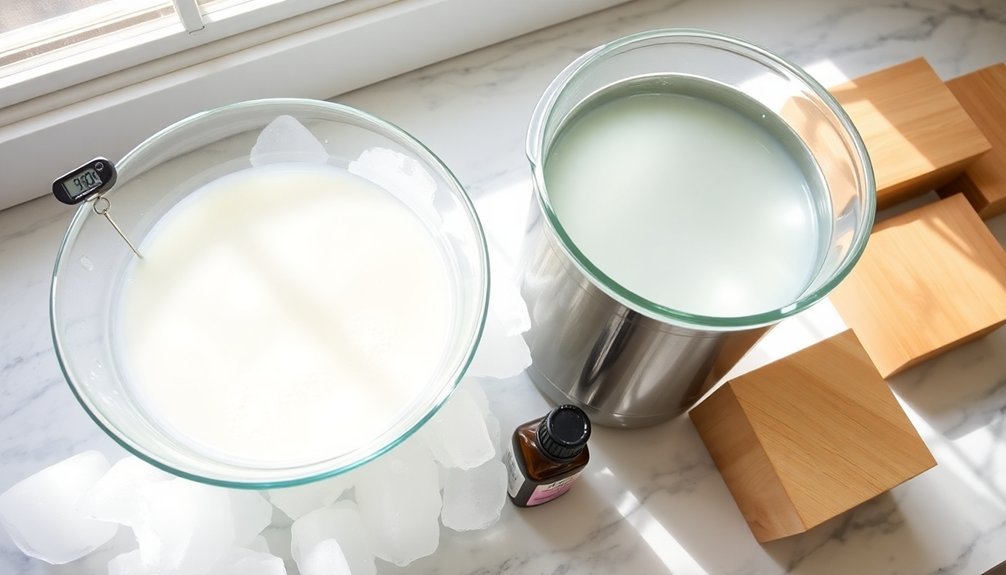
Since proper temperature control forms the foundation of successful summer soap making, pre-cooling your ingredients becomes essential before they ever meet. During hot months, your lye solution can reach a dangerous 200°F when water and lye combine in their exothermic reaction.
| Pre-Cooling Method | For Lye Solution | For Oils |
|---|---|---|
| Refrigeration | Cool to 120-130°F before mixing | Especially important for hard oils |
| Ice Bath | Place container in ice water | Prevents premature melting |
| Fan Cooling | Circulate air around container | Reduces ambient temperatures |
| Temperature Monitoring | Use thermometer to track cooling | Keep within 10° of lye solution |
Always monitor temperatures throughout the saponification process to avoid false trace. By implementing these pre-cooling techniques, you'll maintain ideal soap making temperatures even when your summer studio feels like a sauna.
Optimal Timing Strategies for Warm Weather Batching
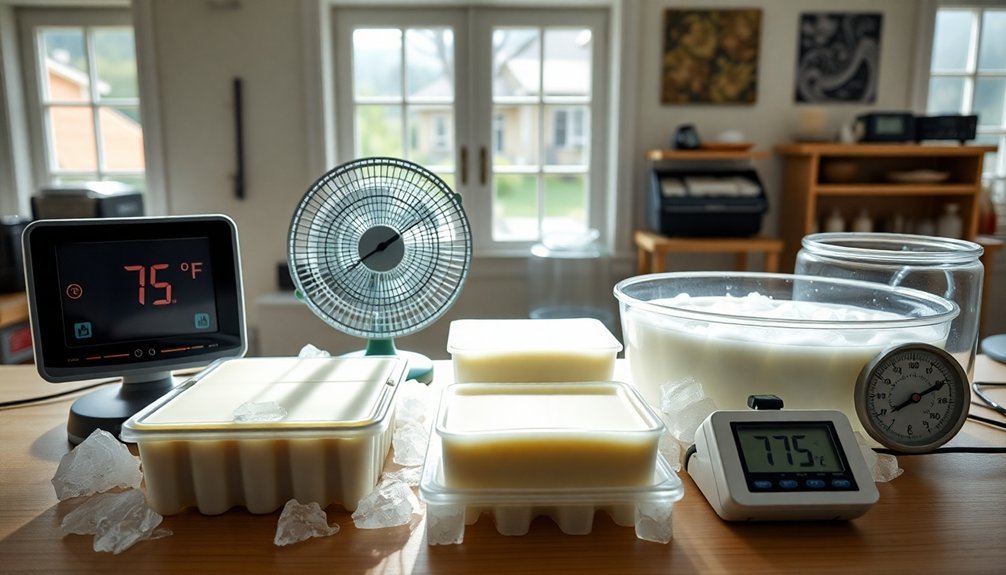
Unlike cooler seasons when you can soap anytime, summer requires strategic timing to prevent temperature-related soap failures. Ambient temperatures greatly impact your lye solution and oil mixture, potentially forcing an unwanted gel phase or causing rapid acceleration.
- Schedule soap-making during early morning or late evening when room temperature is lowest.
- Prepare your hot lye solution the night before, allowing it to cool to 120°F before combining.
- Use a temperature gun to monitor both your oils and lye, keeping them within 10°F of each other.
- Consider refrigerating soap molds when working with milk soaps or when you want to prevent gel phase.
Equipment Modifications for Temperature Management
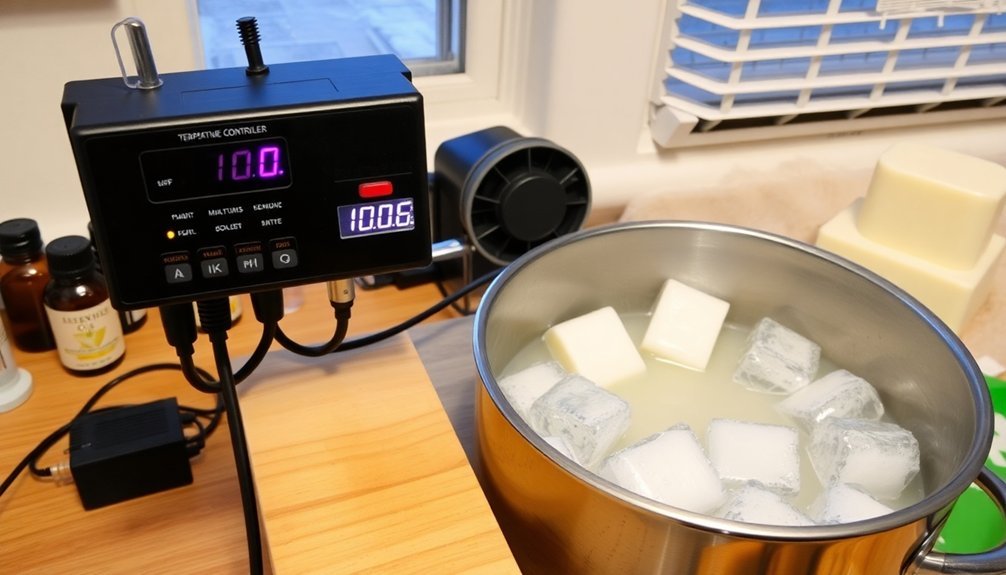
As summer temperatures climb, your soap-making equipment requires strategic adaptations to maintain consistent results. Incorporate an insulated container or cooler to keep oils and lye solutions within the best 120-130°F range for proper saponification. A thermometer with alarm offers precision monitoring, alerting you when temperatures drift beyond perfect parameters.
| Equipment | Function | Temperature Management |
|---|---|---|
| Slow Cooker | Gentle Oil Heating | Controlled melting of hard fats |
| Insulated Cooler | Solution Storage | Maintains consistent temperatures |
| Heating Pad | Stable Warmth | Adjustable temperature control |
Consider using a fan to lower the ambient temperature in your workspace. Temperature-controlled heating pads provide reliable warmth when needed, while double boilers offer gentle heating alternatives. These modifications guarantee your summer soap batches maintain perfect controlled temperature conditions despite challenging weather.
Formulation Adjustments for Hot Weather Conditions
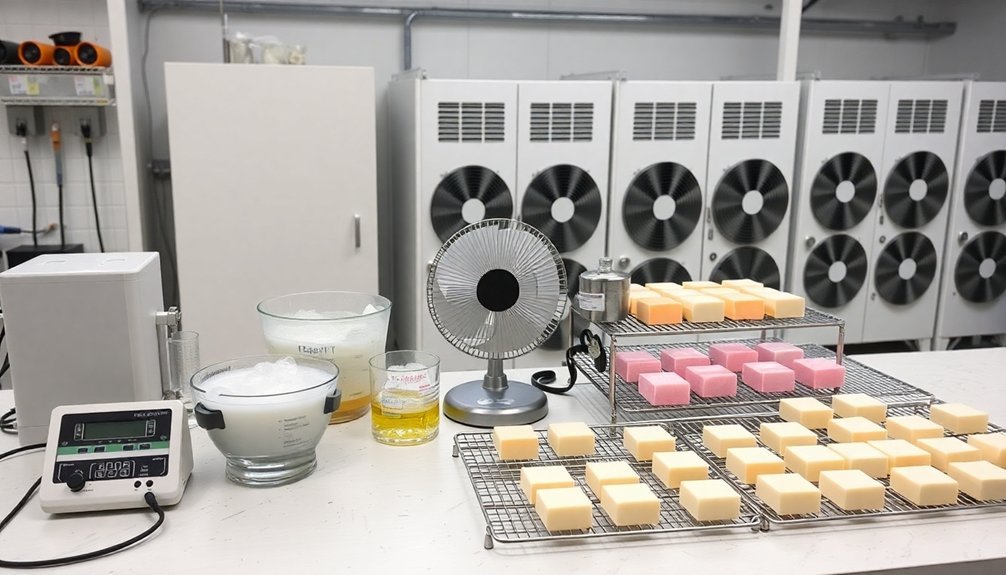
When summer heat threatens your soap-making process, strategic recipe adjustments become essential for maintaining quality results. Increasing water content in your soap recipes helps regulate temperature in cold process soaping by absorbing excess heat during saponification. Your lye solution should be cooler than usual—aim for room temperature rather than the typical warm recommendation.
- Replace solid oils high in saturated fat with liquid oils like olive or sunflower to prevent premature solidification.
- Implement cooling techniques such as placing your mixing container in an ice bath during formulation.
- Reduce your fragrance load by 10-15% as heat accelerates scent reactions.
- Consider manual adjustments to stirring intensity—gentler stirring generates less friction heat.
These water temperature and oil composition modifications will help you maintain control even when ambient temperatures soar.
Monitoring and Maintaining Consistency During Curing
Summer's intense heat creates substantial challenges for soap makers during the essential curing phase. You'll need to regularly monitor both environmental conditions and your soap's response to maintain quality.
Document temperature and humidity levels in your curing area, as these greatly impact saponification outcomes. Aim to keep lye and oils within 120-130°F to prevent false trace issues.
When the mercury rises, implement cooling techniques like reducing sugar content or soaping at lower temperatures to avoid excessive heat build-up.
Proper insulation becomes vital for consistency – wrap molds in towels or use heating pads to maintain stable temperatures throughout the soap.
Remember that summer conditions often necessitate extended curing times, allowing your soap to properly harden despite the heat. This patience guarantees your final product maintains its intended texture and appearance.
Frequently Asked Questions
What Is the Best Temperature for Saponification?
You'll achieve the best saponification results at 120-130°F for both oils and lye. Keep them within 10 degrees of each other to prevent false trace and guarantee proper chemical reaction during cold process soapmaking.
How Do You Cure Soap in a Humid Climate?
In humid climates, you'll need to cure soap in well-ventilated areas. Use dehumidifiers, place soap on wire racks for air circulation, reduce sugar content in recipes, and extend curing time while monitoring for hardness before packaging.
What Is the Effect of Temperature on the Saponification Reaction?
Temperature directly impacts your saponification reaction. If it's too hot (>160°F), you'll get soap volcanoes; too cold causes false trace. Aim for 120-130°F with your lye and oils within 10° of each other.
What Happens if Cold Process Soap Gets Too Hot?
If your cold process soap gets too hot, you'll risk gel phase issues, alien brain formation, soap volcanoes, glycerin rivers, false trace, and cracking—especially in recipes with high butter content or fruit additives.
In Summary
Don't let summer heat melt your soap making dreams. You've got powerful tools to control saponification: pre-cooling ingredients, strategic timing, modified equipment, adjusted formulations, and careful monitoring. With these approaches, you'll maintain ideal temperatures throughout your process, ensuring beautiful, consistent soap even on the hottest days. Master these techniques and you'll create high-quality cold process soap year-round, regardless of outdoor conditions.





Leave a Reply